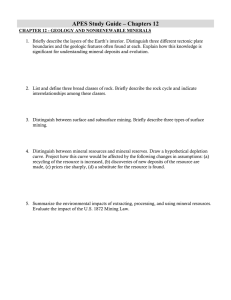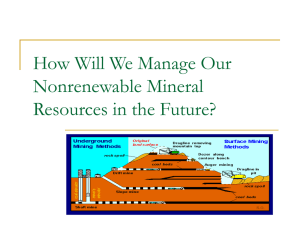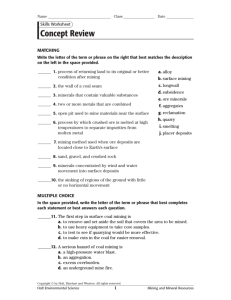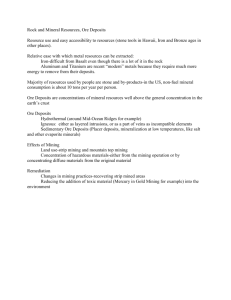Energy Resources and Consumption Unit
advertisement
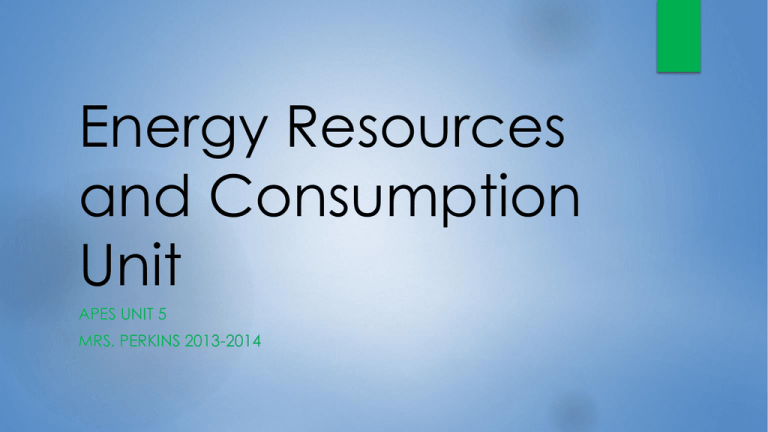
Energy Resources and Consumption Unit APES UNIT 5 MRS. PERKINS 2013-2014 January st 21 2014 Learning Goals: By the end of this lesson Students will be able to: • explain the rock cycle. • Identify mineral resources, environmental effects of using them, and explain how we can use them more sustainably. Agenda: Since it has been a while since we discussed the geological processes of the Earth and we have had some new students added since that time…. 1. Mineral Resource Notes 2. Discussion of Solar House Lab 3. Homework earth’s processes assessment questions 14-3 What Are Mineral Resources, and what are their Environmental Effects? Concept 14-3A Some naturally occurring materials in the earth’s crust can be extracted and made into useful products in processes that provide economic benefits and jobs. Concept 14-3B Extracting and using mineral resources can disturb the land, erode soils, produce large amounts of solid waste, and pollute the air, water, and soil. What is a Mineral Resource? Mineral Resource: A concentration of naturally occurring material from the earth’s crust that can be extracted and processed into useful products and raw materials at an affordable cost. We know how to extract more than 100 minerals from the earths crust Due to their formation time these are nonrenewable resources. We Use a Variety of Nonrenewable Mineral Resources Mineral resource Fossil fuels Coal Metallic minerals Aluminum, Nonmetallic Sand, iron and copper minerals gravel, and limestone We Use a Variety of Nonrenewable Mineral Resources Ore is a rock that contains a large enough concentration of a particular mineral-often metal-to make it profitable for mining and processing. High grade ore Contains a fairly large amount of the desired nonrenewable mineral resource. Low grade Ore Contains a smaller amount Nonrenewable Metal and Nonmetal mineral resources are an important part of our lives. Aluminum (Al) Steel is an essential alloy of iron (Fe) and other elements that give it the ability to be a good building material. Widely used in the electric industry due to its conductibility Platinum (Pt) Manganese(Mn), Cobalt (Co), molybdenum (Mo) and Chromium (Cr) are all steel alloys used in things such as light bulbs, computers, oil drilling equipment Copper (Cu) Packaging, Beverage cans, Structural material (cars, planes, buildings) Catalyst (helps to speed up reactions) in electrical equipment also found in car pollution converters Gold (Au) Used in jewelry, coils, and electrical equipment. It can also be used as a catalyst. Nonrenewable Metal and Nonmetal mineral resources are an important part of our lives. Sand Mostly silicon dioxide (SiO2) Used to make glass, brick and concrete Gravel Used for roadbeds to make concrete Limestone Mostly calcium carbonate (CaCO3) Crushed to make road rock, concrete and cement Mineral Use Has Advantages and Disadvantages Advantages Disadvantages Generates significant income Take great amounts of energy Local state and national revenues Can disturb land Provides employment in a variety of jobs Erode soil Produce solid waste Pollute air water and soil The Life Cycle of a Metal Resource Each step in this process uses larges amounts of energy and produces some pollution and waste. Extracting, Processing, Using Nonrenewable Mineral and Energy Resources Question: What are three mineral resources that you used today? Which of these harmful environmental effects might have resulted from obtaining and using these resources? There Are Several Ways to Remove Mineral Deposits After suitable mineral deposits are located several different mining techniques are used to remove them depending on location and type. Surface mining Remove shallow deposits Large equipment strips away overburden which is the soil and rock overlying a useful mineral deposit. Overburden is then discarded as waste called spoils It is used to extract about 90% of nonfuel mineral and rock resources 60% of the coal is used in the United States Subsurface mining Remove deep deposits Types of Surface Mining 1. Open-Pit Mining 2. Machines dig holes to remove ores (iron, copper, and gold) sand gravel and stone (limestone and marble) Strip Mining Useful and economical for extracting mineral deposits that lie close to the earth’s surface in large horizontal beds. Area Strip Mining is used where the terrain is fairly flat, gigantic earthmovers strip away the overburden and power shovels Some as large as a 20 story building Resulting trenches are filled with overburden A new cut is made parallel to the previous one and the process is repeated over the entire site Types of Surface Mining 3. Contour strip mining Used mostly to mine coal on a hilly mountainous terrain. Huge power shovel cuts a series of terraces into the side of a hill Earthmover removes the overburden and a power shovel extracts the coal and overburden from each new terrace is dumped on the the one below. A highwall is left in front of a highly erodible back of soil and rock, unless the land is restored. Mountain top removal Prominent in the Appalachian mountain area Uses explosives, large power shovels, and huge machines called draglines are used to remove the top of a mountain and expose seams of coal. Subsurface Mining Used to remove coal and metal ores that are too deep to be extracted by surface mining Miners dig a deep vertical shaft blast open subsurface tunnels and chambers to reach the deposit. Machinery is used to remove ore or coal and transport it to the surface. Open Pit Mine Located In Australia is the worlds largest gold mine. Banks of waste or spoils left behind by area strip mining in Colorado Undisturbed Land Overburden Ar Contour Strip Mining of Coal as used in hilly or mountainous terrain Soil Banks Mountain Top Mining in West Virginia Are you for or against mountain top mining? Explain your answer. Mining Has Harmful Environmental Effects Strip top mining Often leaves hill top waves of rubble called spoils banks Very susceptible to chemical weathering Erosion by water and wind. Regrowth of vegetation on these banks is slow because of lack of topsoil Primary ecological succession is the regrowth option. Mountain Top Removal Large machines are used to plow great volumes of waste rock and dirt into valleys below the mountaintops Destroys forests, burying mountain streams and increasing flood hazards Toxic wastewater produced when the coal is processed is often stored in valleys behind coal waste sludge dams Mining Has Harmful Environmental Effects According to the EPA about 1900 kilometers of Appalachia's rivers and streams have been buried 470 of its largest mountains have disappeared leaving behind barren land and gigantic pits, some as large as Manhattan Island In 2007 the U.S Department of the Interior issued a rule that allows Mountain tope removal mining to continue with expanded dumping of mine waste into streams and valleys. Within a few years of an area the size of Delaware! Since the 1980’s have entered into tropical areas including forests looking for gold. Use destructive techniques to dig large pits by hand and dredge sediments from rivers. They also use hydraulic mining techniques in which water cannons wash entire sections into collect boxes. Mining Has Harmful Environmental Effects Subsurface mining disturbs less than one tenth as much land as surface mining disturbs, and usually produces less waste. It does leave much of the resource in the ground and is more dangerous and expensive than surface mining is. Hazards include: Cave-ins Explosions Fires Disease such as black lung from inhaling mining dust Mining Has Harmful Environmental Effects Mining operation also produce large amounts of solid waste Three fourth’s of the solid waste in US is from mining operations One example is the huge amounts of solid waste left behind from mining gold. Mining causes major pollution of air and water Due to wind and water erosion causing toxin laced mining wasted to be deposited in areas other than the mining site X Acid mine drainage occurs when rainwater seeping through a mine or a mine waste pile carries sulfuric acid (H2SO4) which is produced when aerobic bacteria act on iron sulfide minerals in spoils. The following video shows how pollution can be caused by mining during the video please write down at least 10 facts. 2 from the beginning 5 from the middle 3 from towards the end Wrap Up Homework-Read through the solar house lab which is posted online come up with a preliminary sketch and plan for your solar house (Due Friday January 24th ) Read the information about mountain top removal http://appvoices.org/end-mountaintop-removal/ write a 4 paragraph reflection of the article (introductory paragraph, pros of mining, cons of mining closing paragraph) (Due Thursday January 23rd ) Start SGQ’s for chapter 14. January th 27 2014 Unit Goal Students will be able to explain how the earth’s geological cycles over millions of years produced many resources that are excavated with several mining techniques. They will also be able to explain the positive and negative effects of the various techniques of surface and subsurface mining by analyzing the methods and materials used for each type. Agenda 1. Go over cookie mining lab with students 2. Go over scale sheet with students 3. Start Chapter 14 Section 4 How Long Will Supplies of Nonrenewable Mineral Resources Last? Concept 14-4A All nonrenewable mineral resources exist in finite amounts, and as we get closer to depleting any mineral resource, the environmental impacts of extracting it generally become more harmful. Concept 14-4B An increase in the price of a scarce mineral resource can lead to increased supplies and more efficient use of the mineral, but there are limits to this effect. Mineral Resources are Distributed Unevenly Some substances in the earth are fairly abundant such as iron and aluminum however other substances such as manganese chromium cobalt and platinum are fairly scarce. Some countries have rich mineral deposits and some have very few or none. During the 1950’s South Korea exported large amounts of Iron and copper. Since the 1960’s they do not have enough to support their growth. Five Countries: United States, Canada, Russia, South Africa, and Australia supply most of the nonrenewable key mineral resources used by modern society. Mineral Resources are Distributed Unevenly South Africa Self Sufficient in Key Mineral Resources Worlds largest gold chromium and platinum supplier United States, Germany, and Russia Consume about 75% of the most widely used metals China Rapidly increasing in its usage of key metals Mineral Resources are Distributed Unevenly: United States Usage Since the 1950’s sharp per capita use of nonrenewable mineral resources. They have depleted some of its once rich deposits of metal mineral resources such as lead, aluminum, and iron. It depends on imports of 50% or more of 24 of its most important non renewable mineral resources. Most U.S imports of nonrenewable metal resources come from reliable and politically stable countries. Availability of four strategic metal resources-manganese, cobalt, chromium, and platinum is concerning they are essential for military operations and economic strength. Supplies of Nonrenewable Mineral Resources Can Be Economically Depleted Future supply of nonrenewable minerals depends on two things 1. The actual or potential supply of the mineral 2. The rate at which we use it We never completely run out however a mineral becomes economically depleted when it costs more to find than it is worth. At that point there are six choices: 1. Recycle 2. Reuse 3. Waste less 4. Use less 5. Find a substitute 6. Do without Mineral Resources are Distributed Unevenly Depletion time is the time it takes to use to use up a certain proportion-usually 80%-of the reserves of a mineral at a given rate of use. When experts disagree when they are using different assumptions about supplies and rates of use Production A Mine, use, throw away; no new discoveries; rising prices B Recycle; increase reserves by improved mining technology, higher prices, and new discoveries C Present Depletion time A Depletion time B Time Recycle, reuse, reduce consumption; increase reserves by improved mining technology, higher prices, and new discoveries Depletion time C January Unit th 28 2014 Goal Students will be able to explain how the earth’s geological cycles over millions of years produced many resources that are excavated with several mining techniques. They will also be able to explain the positive and negative effects of the various techniques of surface and subsurface mining by analyzing the methods and materials used for each type. Agenda 1. Collect Cookie Mining Lab / Students do Goal and Scale Check 2. Finish Chapter 14 Section 4 with students 3. Talk about SGQ’s for Chapter 14 4. Discuss AP exam Prep for Wednesdays Market Prices Affect Supplies of Nonrenewable Minerals Geological Processes determine the quantity and location of a mineral resource in the earth’s crust. Economics determines what part of the known supply is extracted and used An increase in the price of a scarce mineral resource can lead to increased supplies and can encourage more efficient use There are limits to this process Market Prices Affect Supplies of Nonrenewable Minerals According to the standard economic theory in a competitive market system a plentiful mineral resource is cheap when its supply exceeds demand When a resource becomes scarce, its price rises. This can encourage exploration for new deposits and stimulate development of better mining technology and make it profitable to mine lower grade ores It can also encourage the search for substitutes and conservation. Some economists say this price effect may not longer apply very well in most developed countries. Industry and government in such countries often use subsidies taxes regulations and import tariffs to control the supplies, demands and prices of minerals to such an extent that truly competitive markets do not exist. Science Focus-The Nanotechnology revolution Read the science focus now. Answer the critical thinking question: How might the development of nanotechnology affect the mining of gold? Refer to the Core Case Study Page 344 to help you. Case Study: The U.S. General Mining Law of 1872 Encouraged mineral exploration and mining of hard-rock minerals on U.S. public lands Developed to encourage settling the West (1800s) Until 1995, land could be bought for 1872 prices Companies must pay for clean-up now Is Mining Lower Grade Ores the Answer? Factors that limit the mining of lower-grade ores Increased cost of mining and processing larger volumes of ore Availability of freshwater Environmental impact Improve mining technology Use microorganisms, in situ Slow process What about genetic engineering of the microbes? Can We Extend Supplies by Getting More Minerals from the Ocean? Mineral resources dissolved in the ocean-low concentrations Deposits of minerals in sediments along the shallow continental shelf and near shorelines Significant sources of sand, gravel, phosphates, sulfur, tin, copper, iron, tungsten, silver, titanium, platinum, and diamonds Hydrothermal ore deposits Recovering them would take more energy and money than they are worth. Super heated water mixing with magma metal compounds precipitate out and deposit around the vents. It costs too much money to extract these deposits Metals from the ocean floor: manganese nodules (Cover 25%-50% of the pacific ocean floor) Effect of mining on aquatic life-could affect marine food webs. Environmental impact-could be less of an impact than on land. Wrap Up Homework-Remember your sketches are due tomorrow for the solar house lab. You need to have the following: A Sketch that is to scale showing the dimensions that your house is going to be A list of martials that you will use to construct your house Why you feel your house will be efficient and save on energy based on your design January th 24 Learning 2014 Goals: By the end of this lesson Students will be able to: • Identify mineral resources, environmental effects of using them, and explain how we can use them more sustainably. Agenda: 1. Collect Solar House Lab Preliminary Sketch 2. Finish Chapter 14 with Section 5 3. Homework-For Monday Read Chapter 15 14-5 How Can We Use Mineral Resources More Sustainability? Concept 14-5 We can try to find substitutes for scarce resources, reduce resource waste, and recycle and reuse minerals. We Can Find Substitutes for Some Scarce Mineral Resources Experts point to the current materials revolution in which silicon and new materials like ceramics and plastics are being used as replacements that can serve as substitutes for various minerals. 2005 builders began using house made of Styrofoam with a ceramic spray called Grancrete. Affordable and twice as strong as structural concrete Will not leak or crack Reduces house frame construction to 1/15th of the cost Reduces need for timber saving trees These blocks are also being used to pave bridges. We Can Find Substitutes for Some Scarce Mineral Resources Plastic has replaced copper, steel and lead in piping Fiber-optic glass cables are replacing copper and aluminum telephone cables In the future nanowires may replace the optic glass cables High-strength plastics and composite materials strengthened by lightweight carbon and glass fibers are beginning to transform the automobile and aerospace industry. They cost less to produce (Less energy usage) They do not need painting (Reduces pollution) They can be molded into any shape Superinsulation is being developed by plastics and gels Replacement is not always the answer substitutions may not always work. Platinum is unrivaled as an industrial catalyst and chromium is an essential ingredient of stainless steel. We Can Recycle and Reuse Valuable Metals After a pure metal is produced by smelting or chemical extraction it is usually melted or molded into the shapes to make products that are used and discarded or recycled. Recycling is a valuable way to reuse valuable or scarce nonrenewable mineral resources For example valuable and scarce metals such as gold silver iron copper steel aluminum and platinum Recycling has a lower environmental impact that that of mining and processing metals from ores. Recycling aluminum scrap or beverage cans produces 95% less air pollution and 97% less water pollution. Less energy is also used when recycling compared to mining and processing aluminum ore. There Are Many Ways to Use Mineral Resources More Sustainability In 1975 Minnesota Mining and Manufacturing Company (3M) began a pollution prevention pays (3P) program. Redesigned equipment and processes Used Fewer hazardous raw materials Identified toxic chemical outputs Recycled or sold them as raw materials to other companies Began making non polluting products By 1998 3M’s overall waste production was down 1/3rd and its air pollution and emissions per unit were lowered by 70% The company saved 750 million in waste disposal and material cost! Sustainable use of Nonrenewable Minerals Case Study: Industrial Ecosystems: Copying Nature Mimic nature: recycle and reuse most minerals and chemicals Resource exchange webs Eco-industrial parks Industrial forms of bio-mimicry Benefits An industrial ecosystem in Denmark reduces waste production by mimicking a food web in natural ecosystems. The waste of one business become the raw materials for another. Think about where and how such a system could be set up here in Orlando. Wrap Up Read Chapter 15 Over the weekend Monday we will review this material and prepare for a quiz. Chapter 14 Study guide is due on Tuesday January 28th which is the day we will have a quiz on Chapter 14 sections 3-5
